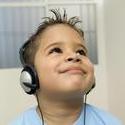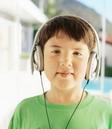|
| |
AIT
and Autism: Autistic Spectrum Disorders (ASD), Auditory Processing
Disorder (APD) and Auditory Integration
Training
Contact Us
Complete
On-line AIT Checklist
by Rosalie
Seymour, SLP/A, Berard AIT Practitioner
What Is Autism?
The Autism Society
of America describes autism as:
“…a complex developmental disability that typically appears during the first
three years of life. The result of a neurological disorder that affects the
functioning of the brain, autism and its associated behaviors have been
estimated to occur in as many as 1 in 500 individuals (Centers for Disease
Control and Prevention, 1997). Autism impacts the normal development of the
brain in the areas of social interaction and communication skills.” ASA, 2000.
The Geneva Centre of Toronto reports
statistics that show an incidence of 1 in 200. The California Health and
Services Agency report to the legislature, 1999, states that the
incidence of autism
has increased dramatically relative to other developmental disabilities,
and that “the accelerated rate appears to be sustaining an upward trend
into future years.” A number of recent surveys currently place the
incidence at 1 in 90. Autism
is four times more prevalent in boys than girls, and knows no racial,
ethnic, or social boundaries.
The clinical picture of
autism
can vary greatly among individuals. No single behavior defines
autism, but rather a cluster of behaviors, and the intensity to
which they are displayed. This variability of the clinical picture of
autism, and its tendency to change with age, and its potential
co-occurrence with other developmental difficulties, leads to
significant difficulties for diagnosis of this condition. In 1998 Dr
Lorna Wing introduced the concept of a spectrum of disorders in
autism, to assist in the understanding of this variability.
It is internationally accepted practice
to express the diagnosis of autism
with reference to this spectrum of potential behaviors, degrees of
handicap, degrees of ability, and associated problems.
In the USA,
autism
is described in the categories outlined in the Diagnostic Standards
Manual - IV (1994) of the American Psychiatric Association, namely:
- Impairment in the quality of verbal
and non-verbal communication; (receptive and expressive.).
- Impairment in the quality of
reciprocal social interaction.
- Markedly restricted repertoire of interests and
activities, that may include obsessions, fixations, and repetitive
movements, and usually includes resistance to learning.
- The Autism Society of America also emphases that
individuals with autism
may experience various problems with sensory feedback or processing of
sensory information.
There are attempts to deal with the
diversity of clinical pictures by identifying different ‘types’ of
autism, such as Kanner’s, Asperger’s, Pervasive Developmental
Disorder (PDD), Rett’s Syndrome, Childhood Disintegrative Disorder. The
criteria for these are outlined in the DSM - IV.
In the United Kingdom, autism is defined
somewhat differently from the USA. While it is agreed that
autism
is of biological origin, the focus is on cognition - on the ‘triad of
impairments’; i.e. socialization, communication, and imagination. The
emphasis is on the ‘theory of mind’ - the ability to ‘mind-read’. This
is the feature said to be universally deficient in autism, according to
Uta Frith, Alan Leslie, and Simon Baron-Cohen (Happé, p 50). Baron-Cohen
has written much on the ‘mentalising’ problems, or ‘mind-blindness’, of
the autistic
condition.
The DAN! (Defeat Autism Now! 1992 to the
present) initiative of the Autism Research Institute of Dr. Bernard
Rimland, has promoted a greater awareness of the biological disorders
common to children (and adults) with
autism. The scientists and specialists involved have demonstrated
the effect of certain biological processes on brain functioning, and
particularly the problems of brain functioning that are typical of
autism. Some scientists now define
autism
as “a condition of neuro-biological origin” ( S.M. Baker & Jon Pangborn,
1997), and there is speculation that
autism
may in fact be a disorder of the gastro-intestinal tract, with the
resulting toxins affecting brain function and development (Shaw, W;
Horvath, K; Wakefield, A; Reichelt, K, in their papers at Barcelona,
2001).
Although the view of
autism
differ, most researchers agree that there is no known cure for
autism. It is often described as a “severe life-long condition”.
This view has received some significant challenges. Evidence is mounting
to support the possibility of recovery from
autism, at least for some individuals. Rimland describes incidents
of ‘spontaneous recovery’; of ‘significant recovery’ (Grandin 1986; Sean
Barron 1992; McDonnell 1993); and of ‘partial recovery’ (Williams 1992,
1994). Recovery attributed to known causes include: Tony Callan 1997
(milk- free diet); Georgie Stehli 1991 (Berard
AIT); the ‘Maurice’ children 1993, and Drew 1994 (Lovaas ABA).
For most children with
autism, it appears that intensive, structured, multi-faceted
intervention offers the best possible outcome (Greenspan, Stehli, and
Giant Steps)
While education (cognitive) is the
most-frequently applied intervention, there is increasing evidence that
dietary (metabolic) interventions provide the more favorable outcomes
(DAN!). In addition, there is increasing evidence of the need for and
value of including intensive sensory interventions. (Williams, Berard ,
Blackman, Grandin, Stehli, Tomatis )
Sensory Processing Difficulties In Autism
Unusual responses by children and adults
to sensations have been described by Jean Ayres (1979). These are
indicative of problems with sensory processing that underlie various
developmental difficulties. This concept has been elaborated by Fisher,
Murray and Bundy in their book “Sensory Integration” (1991). Drs
Courchesne (1987), Delacato (1974), and Ney (1979) were among the first
who investigated the problem of altered sensory processing in
autism. Kanner (1943) had noted the childrens’ unresponsiveness to
certain sounds. Accounts from case
studies
abound indicating sensory processing or modulation differences in people
with autism
( Grandin, Stehli, Williams, Delacato). Dahlgren and Gillberg (1989)
point out that the appearance of sensory differences may be the first
indication that something is wrong with the child who is later diagnosed
with autism.
Of all the sensory modulation problems
that beset people with autism, poor
auditory modulation seems to be one of the most problematic. It is a
difficulty that hampers attention and concentration, as well as
sociability and the development of communication (Stehli, 1991; 1994;
Williams (1999) First-hand reports by people with
autism
describe the distress and confusion that result from inadequate auditory
modulation. (Williams, Grandin, Stehli ). Courchesne, Lincoln, Kilman
and Galambos (1985) found the neurophysiology for auditory modulation to
be more impaired than the visual, in people with
autism.
Auditory Problems in Autism
Tomatis (1970), Koegel & Schreibman
(1976), as well as Hayes and Gordon (1977) have linked problems of
auditory modulation to behavioral and attention problems, and to speech
and language difficulties, and to dyslexia. Katz and Kusnierczyk (1993)
have described auditory modulation disorders according to their effect
on processing speed, on speech-in-noise processing, hypersensitivity,
poor attention, auditory-visual integration, sequencing, and auditory
memory problems. They demonstrate that these auditory problems will
hamper reading and spelling, and comprehension.
Katz and Wilde point out that it is
common for children with auditory processing disorders to come to the
unfavorable attention of school staff and even the police. It seems
clear that the impact of auditory processing problems on an individual
can be profound. Dr. Guy Berard has entitled his book
“Hearing Equals Behaviour” to emphasize this link, and he describes the improvements in
attention, responsiveness, behavior, speech and language that occur
when auditory sensory modulation improved.
Delacato (1974) documented how a child
could be unresponsive to certain sounds (act as-if deaf), but have an
exaggerated response to other sounds. Dr Bernard Rimland (1964)
indicated that his research found 40% of people with
autism
to suffer from hyper-processing of the auditory stimuli, or
‘hyperacusis’. From accounts, it appears that this hyper-hearing leads
to social withdrawal, speech problems, and overload behavior in the
form of tantrums and aggression.
However, over-sensitive hearing is not
the only auditory symptom of the poor modulation of sound that is common
in autism: Wong and Wong (1991),
Courchesne (1987), and Condon (1975) have described longer transmission
time in the brainstem, resulting in slow processing of sound. Tallal
(1996), Merzenich et al (1996) , and Kraus et al (1996) found that
children with ‘language-based learning impairments’ had major
difficulties with ‘temporal processing’ at brainstem level. That is, the
brainstem cannot adequately process rapidly-changing sounds as in
speech, and thus cognitive auditory functions will be negatively
affected leading to comprehension problems and learning difficulties.
Bauman and Kemper (1994), found
brainstem and cerebellar differences in
autism, indicating structural bases for sensory processing problems.
Rosen and Galaburda (1995) have found structural differences in the
medial geniculate nucleus of the brainstem – which is also an area for
processing fast-changing sounds.
Cerebral blood-flow studies by Garreau
and associates (1994) revealed the
autistic auditory response to be atypical (right hemispheral)
compared to non-autistic listeners (left hemispheral).
It is evident, then, that sensory
processing or modulation differences in
autism
can underlie the well-documented cognitive defects of people with
autism, and may even lead to severe challenging behaviors. Of these
differences, research seems to indicate that the auditory is often the
most severely disrupted, with implications for communication, speech and
language, and socialization.
Auditory sensory modulation problems
have received little attention in
autism,
except for the symptom of painful hearing (hyperacusis). The management
of this has been through wearing of earplugs (Delacato), or metabolic
intervention through taking magnesium supplements with vitamin B6. This
has seemed to be effective in some cases (Rimland – website of
autism
Research Institute ).
The Beginning of Auditory
Integration Training (Berard AIT)
The first auditory technique to have
been developed, was the ‘oreille electronique’, by Dr. Alfred de
Tomatis, described in his book ‘Education et Dyslexie’ in 1962. His
theories and practice were hailed by a storm of criticism, as is the
typical response to new ideas. This approach first gained acceptance in
Canada, and then internationally. It has recently become a widely
accepted, even fashionable treatment.
A former colleague of Dr Tomatis,
Dr. Guy
Berard revised the basic concepts underlying the ‘electronic ear’, to
shift from the emphasis on emotional ‘bonding’, to focus upon the
mechanics of the hearing response. Through re-working the application he
was able to achieve more significant changes in a shorter time of
intervention.
In recent years, there have been many
adaptations of these two doctors’ theories and techniques: e.g. Samonas,
Johansen, Digital Auditory Aerobics, and Ease-Disc. Other auditory
attention-altering approaches have also come to the fore, e.g.
BioAcoustics, Fast ForWord (Tallal), Hemi-Sync, Structured Listening,
etc..
Changes in behaviors have been reported
along a wide spectrum of possibilities, behavioral, attentional, and
communicative (Veale, 1993; Berard 1993; Stehli ed. 1995).
The Berard AIT Auditory
Integration Training As An Intervention for Autism
In 1991 the release of the book “The
Sound of a Miracle - A Child’s Triumph Over Autism”, by
Annabel Stehli
introduced Auditory Integration Training (Berard
AIT) - the Berard Method to the English-speaking world. In this
account, a mother tells of her daughter’s Georgiana’s recovery form
autism. This girl had been diagnosed by several reputable
autism
specialists in New York, USA, and had received various structured,
carefully-monitored therapies. However, the parents, and Georgie
herself, ascribe her breakthrough recovery to this ten-day auditory
training which, in their opinion, opened the door to the progress that
followed. International public and professional interest has led to this
method being practiced in most countries in either its original form or
some adjusted format.
Dr. Guy Berard, a French Ear-Nose- and
Throat Specialist in France, devised this new auditory re-training
technique. His book describing the process was translated into English
in 1993 as “Hearing Equals Behaviour”. His technique had been practiced
in Europe and Canada for approximately 30 years before the English
translation was published. Dr Berard devised
Berard AIT
in response to his own progressive hearing loss. Besides benefiting his
hearing problem,
Berard AIT was found to be an effective auditory training method
with a much wider application than hearing loss. It is used as an
auxiliary intervention for conditions in which hearing (or, more
properly, ‘listening’, or auditory processing, ) plays a significant
role.
Berard AIT was soon found to
benefit children with autism
in unexpected ways. Beyond assisting them with their dyslexia or
speech/language development, there were improvements reported in
responsiveness, activity levels, sensory processes, and social skills,
and even their sense of well-being.
Berard AIT has been reported to be helpful to children and adults
alike. It seems to have benefits for those with or without diagnoses, as
a tool for improving listening skills. That is, anyone who needs to
listen, for any reason, can benefit from listening training.
Berard AIT began to receive
widespread media attention as a useful intervention in
autism. The growing public interest prompted research into the
validity of
Berard AIT, to determine whether there was substance to any of the
anecdotal reports by parents and practitioners of improvements. To-date,
there have been approximately
28 published studies, with several of these appearing in
peer-reviewed journals for speech therapists and audiologists, and the
journals for autism. Although it is
not a treatment for
autism
as such, many
studies have focused on the effect of
Berard AIT
on autism. Clinical outcome
studies
have tended to validate reports that
Berard AIT brings about changes in a wide variety of areas of
functioning, with no reported long-term negative effect, nor risk of
causing harm.
Since 1992, many practitioners of
Berard AIT have been certificated and provide this auditory training
in many countries around the world.
The Listening Test and Course of
Sessions
It is necessary here to clarify the
misconceptions about auditory testing for
Berard AIT: the auditory testing of people with
autism
just for the purposes of
Berard AIT
is a practice that Dr Berard does not support.
He states as reason the inadequate
levels of reliability of the responses of people with
autism
to behavioral or response audiometry. However, where it is possible to
readily obtain a reliable
Audiogram
or Listening Test, these results
might be useful to indicate the desirability of setting the additional
specific filters. However, at this time research supports the belief
that
Berard AIT
proceeds effectively without the additional filter settings (Rimland and
Edelson, 1994).
The practitioner may find indications to
set some specific filters depending on the client’s listening graph, if
an accurate one could be obtained. The sessions proceed in a manner
likened to an aerobic or exercise program - commencing with mild
exertion and increasing to optimum levels. This level of exertion
relates to the loudness of the sound input. Sound levels are kept to
within the determined levels of safety, and no auditory risk is posed by
Berard AIT.
This method does not require
the client trying to listen, nor application of the conscious mind to
the task. It seems that in
Berard AIT the mechanisms of the ear receive a ‘passive massage’,
and this has the effect of ‘toning up’ or ‘tuning in’ the listening
mechanism.
Following the ten-day course, no further
action is recommended specifically to enhance the benefits of the
course. No ‘top-up’ sessions are required or recommended. It is however
most important to ensure that the child does not use headphones to
listen to music (e.g. walkman, MP3 ). The Client must avoid exposure to
loud music – as in disco music, etc. Another feature to ensure
Berard AIT benefits are not lost, is to ensure that there are no
ongoing dietary imbalances or neuro-biological conditions left
untreated.
It is recommended to wait for three to
four months after the training before finally assessing the results of
the intervention. After an interval of 9 to 12 months the process may be
repeated, often with continuing benefit.
Changes in behaviors have been reported
along a wide spectrum of possibilities, behavioral, attentional, and
communicative (Veale, 1993; Berard 1993; Stehli ed. 1995). Reading the
research reports on
Berard AIT gives an indication of the kinds of results one may
expect from a course of
Berard AIT.
The list of references is available from the author, Rosalie Seymour, SLP/A.
| |
|






